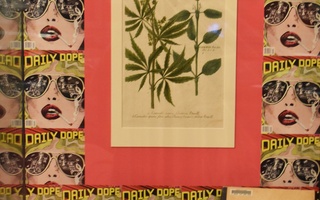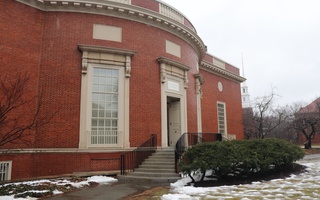Houghton is described as a rare books and manuscripts library, but that description is definitely a misnomer. The library’s collection is not only restricted to books and manuscripts, nor does it stop in the realm of the printing, graphic, and book arts either. A significant part of the Houghton archive is composed of physical objects that sometimes have nothing to do with books and manuscripts, and that barely explored corner of the collection yields some of its most fascinating articles. The home of these realia is the Z-Closet Collection, which students can explore online on HOLLIS. The items there, some of which are listed below, are some of the most unique and unconventional materials in the library. Their presence in the library’s archive, however, only makes it a richer place, and the objects and the stories they tell can yield interesting approaches to the personalities and events to which they are connected.
First and foremost, the Z-Closet contains a surprising number of famous people’s death masks. Although this sounds morbid, death masks are a fascinatingly personal way to come into contact with figures who were larger than life. Death masks also bring us closer to a quintessentially human aspect of these timeless personalities: their mortality. Among the death masks at Houghton, one can find those belonging to American poet e. e. cummings, Irish novelist James Joyce, Harvard professor and renowned philosopher and psychologist William James, American novelist Henry James (supposedly cast by William James, who was his nephew, after a request by American impressionist painter John Singer Sargeant), English dictator Oliver Cromwell, Emperor Napoleon I of France, American editor and scholar Charles Eliot Norton, Italian poet Dante Alighieri, and American poet Walt Whitman, among others.
Other eerie relics kept in the closet are multiple locks of hair—again, a peculiar yet personal way to interact with history’s notables. When reading a history textbook or writing a literature paper, the people described therein often appear to be disembodied phantoms; their historical weight, it seems, dehumanizes them. Seeing and thinking about something like these people’s hair brings them back into the world in a tangible way, and understanding how and why their hair was conserved in the first place also helps to determine] their cultural context and personal history. Houghton has hair that belonged to Scottish novelist Robert Louis Stevenson, English Romantic poet William Wordsworth, Napoleon Bonaparte, American Dark Romantic novelist Nathaniel Hawthorne, and Scottish philosopher Thomas Carlyle.
Also worthy of mention are a copy of “Oidhche Sheanchais,” the first sound motion picture in Irish; top secret maps from the First World War made for General Pershing as he battled the Germans in France; a brick from President Ulysses S. Grant’s temporary tomb; a Thai printing type from the nineteenth century; the key to Napoleon’s bedroom in the South Atlantic island of St. Helena, where he was exiled until his death in 1821, as well as the emperor’s stationery; George Washington’s mantel clock; a colonial Massachusetts coin collection; English novelist Charles Dickens’s walking stick, ivory letter opener, and brass seal; T. S. Eliot’s panama straw hat, which Eliot purchased at the Coop; Victorian English art critic John Ruskin’s magnifying glass, which, according to a manuscript text in its box, was “always in his pocket”; and even a Yale Bicentennial medal made by Tiffany & Co.
The Z-Closet also contains my favorite item at Houghton: an alarm clock from Communist China depicting Mao Zedong surrounded by followers waving copies of his “Little Red Book” (call no. MS Chinese 15, HOLLIS no. 014347915). A modern anthropological relic from the Cultural Revolution-era, totalitarian society where mass production is the norm, it can be studied from a surprising variety of lenses and contextualized in multifarious ways. Like everything else listed above—and everything at Houghton in general—the clock tells someone else’s story, but also has a story of its own that is worth exploring.
———
Houghton’s Z-Closet Collection can searched as an author on HOLLIS Classic (http://lms01.harvard.edu).
Read more in Arts
An Empire of SignsRecommended Articles
-
Houghton Library Obtains Lord Tennyson CollectionHoughton Library has purchased the world's most impressive collection of Alfred, Lord Tennyson's manuscripts, William A. Jackson, director of Houghton
-
CIRCLING THE SQUAREWhen Houghton Library opened, three months after Pearl Harbor, it was described as "fireproof, earthquake-proof, and reasonably protected against the
-
Horror at Houghtonhe library, as a collector of old books and manuscripts, has plenty of creepy stuff that is not the human skin-bound book bound lying around in the stacks, and any horror enthusiast will have a field day exploring the collection items below.
-
 ‘LSD’ Houghton Exhibit Showcases Counterculture Paraphernalia
‘LSD’ Houghton Exhibit Showcases Counterculture Paraphernalia -
 Donor’s Collection of Children’s Literature Sparks Houghton Library Renovations to Increase Accessibility
Donor’s Collection of Children’s Literature Sparks Houghton Library Renovations to Increase Accessibility













